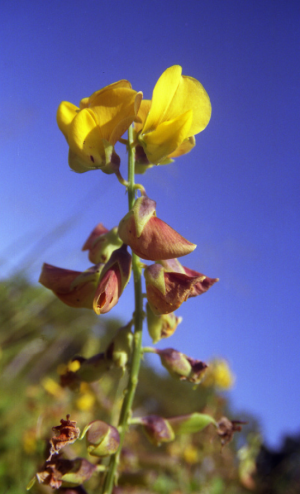Scientists discover mechanics of poison production in crotalaria herbaceous plants

"Many plants require nitrogenous soil to grow. However, these soils are not available in all regions. Some species therefore form a symbiosis with soil bacteria, allowing them to bind nitrogen from the air", explains Professor Dietrich Ober from the CAU's Botanical Institute. In return, the bacteria get nutrients from the plants. This symbiosis allows plants, such as peas or clover, to grow on nitrogen-poor soils – and in agriculture it replaces artificial fertilisers. The nitrogen is bound in what are known as 'root nodules', symbiosis structures, similar to organs, formed jointly on the root by bacteria and plant alike.
"Our working group studies the evolution of pyrrolizidine alkaloids. These are poisons, produced by some plants as protection against herbivores", says Ober. One example for such a plant occurring here in Germany is the infamous ragwort (Senecio jacobaea), which appears in the media again and again, because it leads to foodstuff contamination in teas and salads. However, the working group's research interest lies in different regions: "We are particularly interested in the tropical and subtropical plant genus Crotalaria, at home primarily in Africa", says Ober's associate Dr Elisabeth Kaltenegger. And: "This genus, comprising over 600 different species, not only produces the poisonous alkaloids, but also lives in symbioses with bacteria to bind nitrogen."
However, the Kiel researchers noticed that Crotalaria grown in their greenhouses is free of alkaloids – and also free of the typical root nodules, which indicate the symbioses with bacteria. In numerous tests to induce alkaloid production in the greenhouse plants, for example by adding artificial nitrogen, it became clear that the plants were missing the symbioses with the correct bacteria for producing the poisons. During the further course of the study the researchers 'infected' the plants with the same rhizobia that occur in the Crotalaria's area of spread. Ober: "A comparison of infected and non-infected samples revealed that only the infected plants produced the defensive substances". At the end of the study the results show that the plants produce the poison themselves, but they only do this in the root nodules populated by the bacteria.
Ober: "Just last month the rhizobia were awarded "Microbe of the Year 2015" because of their growth-promoting properties by the Association for General and Applied Microbiology (VAAM). It now emerges that the influence of the bacterium on the plant's survival capabilities is even greater than was previously assumed."
More information: "New aspect of plant–rhizobia interaction: Alkaloid biosynthesis in Crotalaria depends on nodulation." Simon Irmer, Nora Podzun, Dorothee Langel, Franziska Heidemann, Elisabeth Kaltenegger, Brigitte Schemmerling, Christoph-Martin Geilfus, Christian Zörb, and Dietrich Ober. Proceedings of the National Academy of Sciences. DOI: 10.1073/pnas.1423457112
Journal information: Proceedings of the National Academy of Sciences
Provided by Christian-Albrechts-Universitaet zu Kiel



















